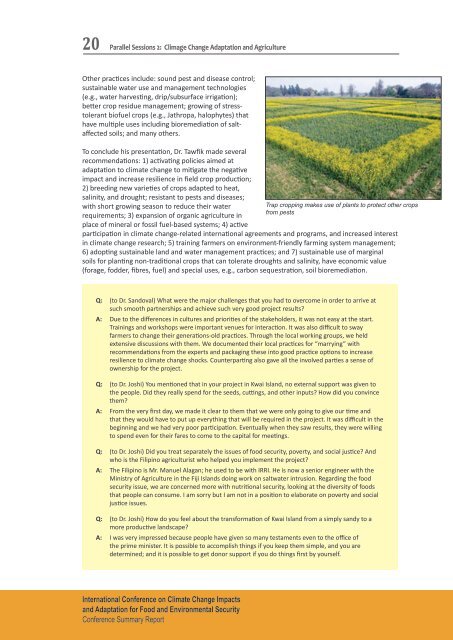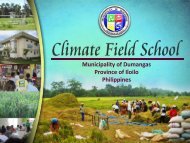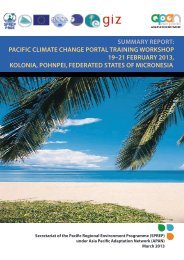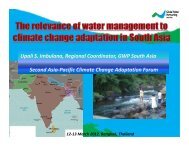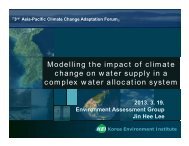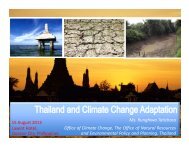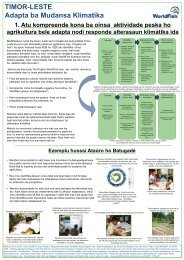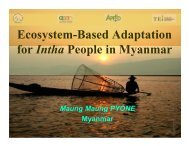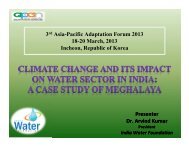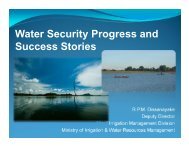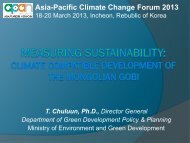PDF file (2.44 MB) - Asia Pacific Adaptation Network
PDF file (2.44 MB) - Asia Pacific Adaptation Network
PDF file (2.44 MB) - Asia Pacific Adaptation Network
Create successful ePaper yourself
Turn your PDF publications into a flip-book with our unique Google optimized e-Paper software.
20Parallel Sessions 2: Climage Change <strong>Adaptation</strong> and AgricultureOther practices include: sound pest and disease control;sustainable water use and management technologies(e.g., water harvesting, drip/subsurface irrigation);better crop residue management; growing of stresstolerantbiofuel crops (e.g., Jathropa, halophytes) thathave multiple uses including bioremediation of saltaffectedsoils; and many others.To conclude his presentation, Dr. Tawfik made severalrecommendations: 1) activating policies aimed atadaptation to climate change to mitigate the negativeimpact and increase resilience in field crop production;2) breeding new varieties of crops adapted to heat,salinity, and drought; resistant to pests and diseases;with short growing season to reduce their waterrequirements; 3) expansion of organic agriculture inplace of mineral or fossil fuel-based systems; 4) activeTrap cropping makes use of plants to protect other cropsfrom pestsparticipation in climate change-related international agreements and programs, and increased interestin climate change research; 5) training farmers on environment-friendly farming system management;6) adopting sustainable land and water management practices; and 7) sustainable use of marginalsoils for planting non-traditional crops that can tolerate droughts and salinity, have economic value(forage, fodder, fibres, fuel) and special uses, e.g., carbon sequestration, soil bioremediation.Q: (to Dr. Sandoval) What were the major challenges that you had to overcome in order to arrive atsuch smooth partnerships and achieve such very good project results?A: Due to the differences in cultures and priorities of the stakeholders, it was not easy at the start.Trainings and workshops were important venues for interaction. It was also difficult to swayfarmers to change their generations-old practices. Through the local working groups, we heldextensive discussions with them. We documented their local practices for “marrying” withrecommendations from the experts and packaging these into good practice options to increaseresilience to climate change shocks. Counterparting also gave all the involved parties a sense ofownership for the project.Q: (to Dr. Joshi) You mentioned that in your project in Kwai Island, no external support was given tothe people. Did they really spend for the seeds, cuttings, and other inputs? How did you convincethem?A: From the very first day, we made it clear to them that we were only going to give our time andthat they would have to put up everything that will be required in the project. It was difficult in thebeginning and we had very poor participation. Eventually when they saw results, they were willingto spend even for their fares to come to the capital for meetings.Q: (to Dr. Joshi) Did you treat separately the issues of food security, poverty, and social justice? Andwho is the Filipino agriculturist who helped you implement the project?A: The Filipino is Mr. Manuel Alagan; he used to be with IRRI. He is now a senior engineer with theMinistry of Agriculture in the Fiji Islands doing work on saltwater intrusion. Regarding the foodsecurity issue, we are concerned more with nutritional security, looking at the diversity of foodsthat people can consume. I am sorry but I am not in a position to elaborate on poverty and socialjustice issues.Q: (to Dr. Joshi) How do you feel about the transformation of Kwai Island from a simply sandy to amore productive landscape?A: I was very impressed because people have given so many testaments even to the office ofthe prime minister. It is possible to accomplish things if you keep them simple, and you aredetermined; and it is possible to get donor support if you do things first by yourself.International Conference on Climate Change Impactsand <strong>Adaptation</strong> for Food and Environmental SecurityConference Summary Report


